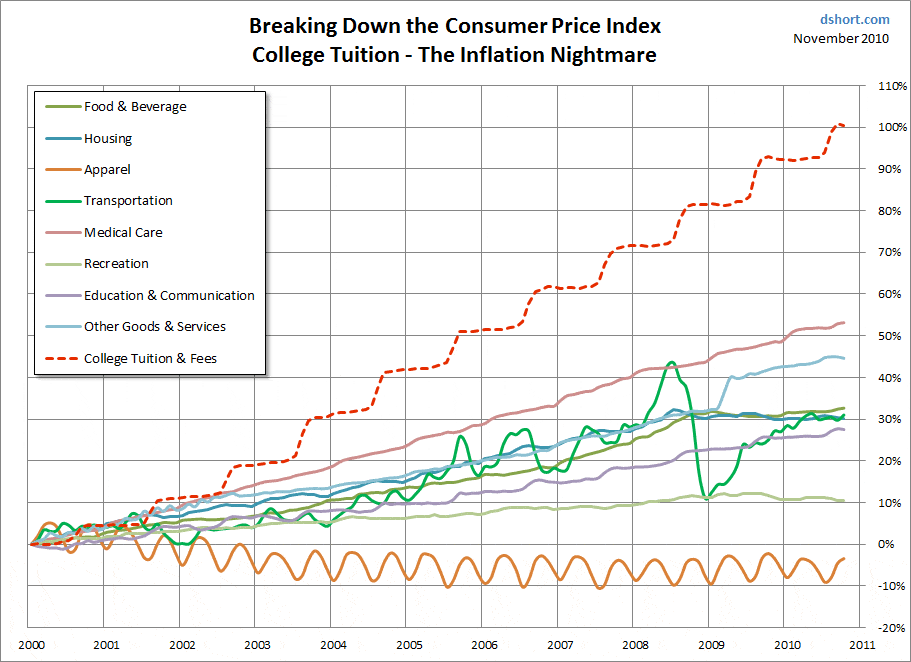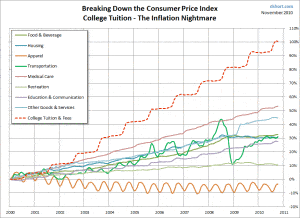The future of college tuition, and therefore student loans; seems to be going only up with no relief in sight. In order to get a better understanding of why, this might be a good time to look back at when the first federal student loan and grant programs were established and how it has fueled the rising tuition costs.
Back when most of our grandparents were attending college, the number of graduates in 1940 numbered only 186,500. For the population at the time, this meant that less than 5 percent of adults 25 and older in the U.S. had a college degree. Of that total, 109,546 of them were men. As an additional reference point, if one of these graduates attended Yale University, it would have cost them $450 per year. Adjusted for the rate of inflation, that $450 in 1940 is worth about $7,200 in the dollars of 2013.
By 1950, the number of college graduates nearly tripled to 432,058. This was due to the passing of the Servicemen’s Readjustment Act in 1944, more popularly known as the GI Bill. This legislation provided for veterans of the Second World War to attend college using federal benefits. Even with these additional numbers, the percentage of adults 25 and older in the U.S. with a college degree was still only 8 percent. Half of these numbers were veterans and 328,841 of them were men.
The first actual student loans backed by the Federal Government were offered in the 1950s under the National Defense Education Act. These were offered as a way to encourage students to pursue math and science degrees after the launch of Sputnik by Communist Russia.
By 1970, the number of college graduates just receiving bachelor degrees had increased to 839,730. Although more than half were men (475,594), the number of women earning a college degree had tripled in just twenty years. By this time, 68 percent of federal aid to college students was in the form of grants. The cost for college had not significantly increased by this point and a Pell Grant could cover approximately two-thirds of tuition annually at many universities.
Our Top Rated Student Loan Lenders
| Lender | Variable Rates (APR) | Fixed Rates (APR) | |
|---|---|---|---|

|
1.99% - 8.56% |
2.95% - 8.77% |
Learn More |
   |
1.74% - 5.64% |
2.44% - 5.79% |
Learn More |
  |
2.39% - 6.01% |
2.79% - 6.69% |
Learn More |
  |
2.43% - 7.84% |
3.48% - 7.03% |
Learn More |
   |
2.56% - 6.87% |
2.59% - 6.74% |
Learn More |
   |
3.24% - 5.54% |
3.34% - 5.69% |
Learn More |
| Lender | Variable Rates (APR) | Fixed Rates (APR) | |
|---|---|---|---|
   |
1.04% - 11.98% |
3.34% - 12.99% |
Learn More |
   |
1.05% - 11.44% |
3.49% - 12.78% |
Learn More |
   |
1.78% - 11.56% |
5.17% - 14.96% |
Learn More |
   |
3.52% - 9.50% |
5.45% - 9.74% |
Learn More |
  |
4.31% - 13.57% APR* |
3.09% - 13.76% APR* |
Learn More |
Education Costs On The Rise
In the late 70s though tuition costs began to rise and have continued to do so steadily every year to today. Here is a short comparison for a four-year degree in 1980 and 2013 in three categories:
- Tuition at a Public Institution – 1980 – $2550 2013 – $7196
- Tuition at a Private Institution – 1980 – $5594 2013 – $15,786
- Average Total Tuition Amount – 1980 – $3449 2013 – $9733
In the last decade, the situation has not improved. The rising cost of higher education has greatly surpassed the general cost of living expenses and medical expenses. While the U.S Government has made it easier for anyone to attend college with the various student loan programs currently available, they have also helped fuel the rising cost of higher education by lending too easily. That degree that was once sought after and had a great impact on someones financial life, is now less valuable due to such a high number of college graduates, yet more expensive to attain. Medical school loan debt has also continued to increase at a rapid rate.
Americas Student Debt Problem
In 2010, the amount of total student loan debt in America reached $830 Billion. This was the first year that another form of personal debt exceeded that of credit card debt, which was $825 Billion that year. In 2013, that number has now grown to over $1 Trillion and will continue to do so at an estimated rate of 10 percent annually. The average debt amount per household with student loans is over $25,000.
Currently, there are 37 Million people in the U.S. with some amount of student loan debt. That is almost 10 percent of the country’s population. To make a bad situation even worse, over half of all recent graduates are either unemployed or jobless. Of the recent graduates who do have a job, many of them are not working in their field of expertise. The biggest employers for this group are Best Buy, Starbucks, Target and Wal-Mart, according to a recent survey of 4 Million profiles on Facebook. What they earn each week in terms of purchasing power is less than what their counterparts made twenty years ago. This all while the federal government is reaping massive rewards on the backs of college students.
For those of you graduating this year and in the near future, here is what you have to look forward to. Over $25,000 in debt at a 6.8 percent interest rate for your Stafford Loan and a ten year repayment plan that many of you will not be able to meet. If you can pay it off in eighteen years, you will have to make a minimum loan payment of $200 every month. The total interest you’ll be paying over that time will be $18,000. That’s over 60 percent of your original loan. If you can’t pay that $200 every month, the length and the amount of the loan will quickly grow into a lifetime of debt. All the while you may have a lender who will profit more off your loan if you are in default, thus making it difficult for you to borrow for a car, or home.
There’s no doubt that higher education leads to a higher level of income earned over a lifetime, but constantly rising tuition and what some call predatory lending are making that impossible for many people. Already 60 percent of those attending college have to take out loans. Despite recent efforts to keep interest rates low, it does not address the basic problems of growing costs and long-term debt.
If you are trying to repay your student loan debts or are just beginning college and want to find the best options, contact us here at Student Debt Relief. Getting you ready to face college and the world after is what we specialize in. Good luck!



